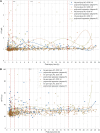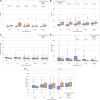Time-Dependent Association of Preinjury Anticoagulation on Traumatic Brain Injury-Induced Coagulopathy: A Retrospective, Multicenter Cohort Study
- PMID: 39446739
- PMCID: PMC11970890
- DOI: 10.1227/neu.0000000000003238
Time-Dependent Association of Preinjury Anticoagulation on Traumatic Brain Injury-Induced Coagulopathy: A Retrospective, Multicenter Cohort Study
Abstract
Background and objectives: The impact of preinjury anticoagulation on coagulation parameters over time after traumatic brain injury (TBI) has remained unclear. Based on the hypothesis that preinjury anticoagulation significantly influences the progression and persistence of TBI-induced coagulopathy, we retrospectively examined the association of preinjury anticoagulation with various coagulation parameters during the first 24 hours postinjury in 5 periods.
Methods: Data from the Japanese registry of patients with TBI aged ≥65 years admitted between 2019 and 2021 were used. Time since injury was classified into 5 categories through a graphical analysis of coagulation parameters. We examined the association between preinjury anticoagulation and the platelet count, prothrombin time-international normalized ratio (PT-INR), activated partial thromboplastin time (APTT), D-dimer level, and fibrinogen level during each period by analysis of covariance using 10 clinical factors as confounding factors.
Results: Data from 545 patients and 795 blood tests were analyzed. The patients' mean age was 78.9 years, and 87 (16%) received anticoagulation therapy. The preinjury anticoagulation group had significantly greater Rotterdam computed tomography scores and poorer outcomes at discharge than the control group, with significantly lower D-dimer levels and higher fibrinogen levels. Analysis of covariance revealed significant associations between the D-dimer level and preinjury anticoagulation within 2 to 24 hours postinjury, APTT and preinjury anticoagulation within 1 to 24 hours, and PT-INR and preinjury anticoagulation throughout all periods up to 24 hours postinjury.
Conclusion: Despite more severe TBI signs and poorer outcomes, the preinjury anticoagulation group had significantly lower D-dimer levels, especially within 2 to 24 hours postinjury. Thus, D-dimer levels during this period may not reliably represent TBI severity in patients receiving anticoagulation therapy before injury. Preinjury anticoagulation was also associated with an elevated PT-INR and prolonged APTT from early to 24 hours postinjury, highlighting the importance of aggressive anticoagulant reversal early after injury.
Copyright © 2024 The Author(s). Published by Wolters Kluwer Health, Inc. on behalf of the Congress of Neurological Surgeons.
Figures






References
-
- Nguyen RK, Rizor JH, Damiani MP, et al. The impact of anticoagulation on trauma outcomes: an national trauma data bank study. Am Surg. 2020;86(7):773-781. - PubMed
-
- Grandhi R, Harrison G, Voronovich Z, et al. Preinjury warfarin, but not antiplatelet medications, increases mortality in elderly traumatic brain injury patients. J Trauma Acute Care Surg. 2015;78(3):614-621. - PubMed
-
- Nederpelt CJ, van der Aalst SJM, Rosenthal MG, et al. Consequences of pre-injury utilization of direct oral anticoagulants in patients with traumatic brain injury: a systematic review and meta-analysis. J Trauma Acute Care Surg. 2020;88(1):186-194. - PubMed
-
- Hecht JP, LaDuke ZJ, Cain-Nielsen AH, Hemmila MR, Wahl WL. Effect of preinjury oral anticoagulants on outcomes following traumatic brain injury from falls in older adults. Pharmacotherapy. 2020;40(7):604-613. - PubMed
-
- Markou M, Pleger B, Grozinger M, et al. Intake of NOAC is associated with hematoma expansion of intracerebral hematomas after traumatic brain injury. Eur J Trauma Emerg Surg. 2021;47(2):565-571. - PubMed
Grants and funding
LinkOut - more resources
Full Text Sources

